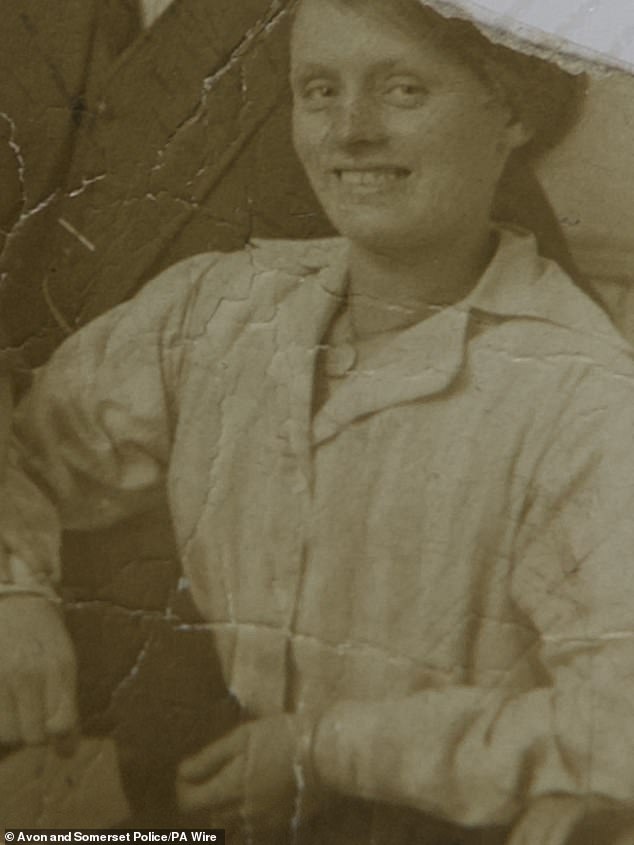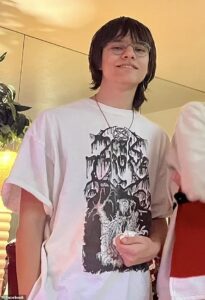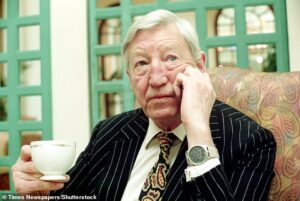
A 92-year-old pensioner will likely die in prison after being convicted of the rape and murder of a 75-year-old widow who was killed 58 years ago.
In what is thought to be the UK’s longest-running cold case ever solved, Ryland Headley has now been found guilty of murdering and raping Louisa Dunne.
Ryland, then aged 34, forced entry into the mother-of-two’s home in Bristol in June 1967 before attacking her.
Her body was found by neighbours inside her terraced home in Britannia Road in the Easton area of the city on the morning of June 28.
A woman was heard screaming hours before Mrs Dunne, who had been twice widowed and lived alone, was discovered dead.
Mrs Dunne, who was using the front room as a bedroom, was found lying on a pile of old clothes and police found no evidence of any violent struggle in the house.
The case remained unsolved for over 50 years until Avon and Somerset detectives sent off items from the original investigation for DNA testing.
Those results provided a DNA match to Headley, who since the murder had moved to Suffolk, and had served a prison sentence for raping two elderly women.
Dramatic footage, shown to jurors, revealed the moment cops busted a the startled sex predator at his home before arresting him.

Ryland Headley, now 92, has been convicted of raping and murdering Louisa Dunne, 75, on the night of June 27 1967. She is seen in photograph taken around 1919.

Court sketch of 92-year-old Headley appearing via video link at Bristol Magistrates’ Court for an earlier hearing

Police body-worn camera footage captured a startled Headley being detained last year on suspicion of killing of Louisa Dunne in what was Britain’s oldest cold case review
Headley, of Ipswich, had denied rape and murder but was found guilty of both charges by the jury at Bristol Crown Court.
The defendant, now aged 92, did not give evidence during the trial.
He is now facing a life sentence – but will more than likely die behind bars.
Detective Inspector Dave Marchant, of Avon and Somerset Police said Headley’s conviction showed no case was ‘too old or too cold’ to be investigated.
He said: ‘We’re unwavering in our determination to bring offenders to justice.
‘For me, there is no cold case which is too old, too cold for us to complete a further review and investigation on.
‘If there are lines of inquiry and evidence, we will pursue them relentlessly. We will do everything in our power to identify offenders to bring them to justice.
‘My message to them is watch your back, we’re coming after you.’
Forces across the country are now examining whether Headley could be linked to other unsolved crimes.
‘Ryland Headley has now been convicted of three rapes of elderly women within their own addresses, and in the case of Louisa Dunne, her murder as well,’ DI Marchant said.

Headley (pictured) had previously been convicted of raping two other pensioners. He has now been found guilty of the rape and murder of Mrs Dunne

A post mortem examination later found Mrs Dunne had suffered multiple bruising and an ‘extensive haemorrhage to the whites of both eyes’
‘In 1978, when he was sentenced, he admitted to a number of other burglary offences.
‘I think there’s every possibility that there are other offences out there – over the 60s, 70s, however long a time period – which Mr Headley could be culpable for.
‘We are working with colleagues across the country and other police forces and the National Crime Agency to try to understand and identify those potential further offences, and if possible, can we match them through any forensic techniques etc and if we are able, hopefully then get him before a court to face justice over those matters too.’
The court heard Mrs Dunne was a ‘local fixture’ who was always ‘standing on her doorstep, watching the world go by, always wearing her headscarf.’
Neighbours found her body when she failed to appear on her doorstep and they noticed a sash window was open.
Mrs Dunne had suffered multiple bruising and a major haemorrhage, consistent with having her mouth forcibly covered to stop her breathing.
At the time police tried to match thousands of potential suspects to a palm print left on a window.
Prosecutors say the case went cold for decades until a DNA breakthrough.
Sex predator Headley was identified after a cold case review last year matched his DNA with semen on Mrs Dunne’s skirt and pubic hair – while his palm was also a match for a print left on a window.

Pictured: The blue skirt Ms Dunne was wearing when she died

Court artist drawing by Elizabeth Cook of Ryland Headley (right) in the dock at Bristol Crown Court
Opening the case for the prosecution earlier this month Anna Vigars KC told the jury: ‘We are talking about the murder of an elderly and vulnerable lady in her own home.
‘She was in no state to defend herself. Whether it happened 58 years ago or 58 days ago, the murder of any person, is, of course, a matter of concern to any of the rest of us.
‘The fact that time has passed does not make the killing of anyone of us any less significant.
‘The police have never given up on solving the case of Mrs Dunne’s murder.’
To give a sense of Headley’s ‘depravity’, jurors heard the harrowing testimony of two elderly widows raped by the ‘animal’ in 1977.
Headley, then aged 45, had broken into the homes of women aged 84 and 79 at night and raped them having threatened them with violence if they did not comply.
Police mounted a massive fingerprinting exercise to try to find the attacker and Headley was arrested after a print found at the second scene matched his.
He later pleaded guilty at Ipswitch Crown Court in 1978 for the pair of sex attacks and was jailed for seven years.
Speaking about the testimony of the two victims, heard by the jurors sitting in Headley’s murder trial, DI Marchant said: ‘Hearing the voices of the victims of his 1977 offences, is just incredibly powerful and harrowing.
‘I think it gives us an insight into probably what happened within 58 Britannia Road to some degree.
‘Mr Headley has offered no evidence for explanation for what happened at that address that night so to hear those women, their accounts being read out in court, I think was very impactful, very impactful.

After the video of Headley’s arrest was shown to the jury, Avon and Somerset Police released the clip publicly – sharing what are the first images of the defendant
‘It just gave a sense of how depraved and predatory Mr Headley’s behaviour is.
‘He’s now three times convicted of rape, stranger rapes, breaking into elderly women’s addresses overnight and subjecting them to just most abhorrent, heinous attacks for his own pleasure.’
Anna Vigars KC, prosecuting, read statements the two women had provided after being attacked by Headley.
The 84-year-old victim described how she had awoken in the early hours of October 1 1977 to the feeling of strong hands over her face and head.
She said: ‘I tried to push his hands away. I tried to bite his fingers but I didn’t have my teeth in.
‘I said ‘Please go, haven’t you got a mother, surely you wouldn’t hurt an old lady of 84?’
‘I said ‘Don’t touch me, I shall scream in a minute’. He said ‘If you do, that will be worse for you’.
‘I was crying. It hurt me. I said “Please go away and leave me alone”.
Headley then told the woman to comply, adding: ‘If you don’t, I will strangle you.’
The woman recalled: ‘I thought to save my life and get it over quickly, I should just give in.
‘I thought he would kill me. I was crying and upset. I said to him “Now clear off”.
‘He said “Have you got any money?”. I said “No, I am an OAP, I think you ought to give me some”.
‘I heard him go downstairs and heard the front door shut with a bang.’

Mrs Dunne, pictured, was a ‘local fixture’ who was always ‘standing on her doorstep, watching the world go by always wearing her headscarf

Headley (pictured in a court sketch by Elizabeth Cook) is now facing a life sentence and will likely die behind bars for his crime
She went downstairs and called for police, noting that curtains were blowing in the bedroom from where Headley had opened a window.
The 79-year-old woman told how she had got ready for bed, placing her false teeth in a cup in the kitchen, and secured her home – checking all windows and doors were locked shut.
She said: ‘The next thing I knew, I was woken up by my main bedroom light flashing on. I saw someone move on the floor. I realised it was a man. He was crawling towards the door.
‘I was petrified. I shouted out ‘Who are you, what are you doing there?’. I saw him jump up and switch the light off. It was so dark.’
Headley then went over to the woman and told her to feel an object, telling her it was a gun.
He then told her: ‘If you do what I tell you, you will be all right. If you don’t, I will kill you. If you scream or make a noise, I will kill you.’
The woman described how she tried to fight Headley off by scratching his face and pulling at his watch before reaching for a lamp on her bedside table.
Headley then used her sheet to tie her wrists.
She told him: ‘Leave me alone, would you want anybody to do this to your mother or sister?”
Headley replied: ‘I will put you on the floor in a minute if you don’t do what I say, I will put a pillow over your face and smother you.”
Trevor Mason, who was a Special Branch detective involved in the 1977 investigation into Headley’s double-rape described the monster as ‘worse than an animal’.
‘What those poor women suffered is just horrendous, absolutely horrendous,’ Mr Mason told Channel 4 News. ‘They were lucky, I suppose, that they weren’t killed, but they weren’t lucky at all, were they?
‘They were obviously frail, they didn’t stand a chance. Absolutely terrible.
‘That’s the man we were after, and thank goodness we found him.’
The granddaughter of Mrs Dunne, who attended every day of Headley’s murder trial, feared the killer would never be brought to justice.
Mary Dainton, 78, told how she ‘accepted’ the man who raped and murdered her grandmother would never been found.
In an interview released following Headley’s conviction on Monday, Mrs Dainton said she was still ‘stunned’ he had been caught.
‘I accepted that some murders just never get solved and some people have to live with that emptiness and sadness,’ she said.
‘The family sort of fell to pieces after the murder. We weren’t a close family in the first place but what there was of the family fell to pieces. I didn’t realise that was happening at the time but I do now.’
She added: ‘I never thought it would be solved. I thought he would never be caught. I never believed they would be able to trace him.’
Describing the moment police told her Headley had been arrested, Mrs Dainton said an officer revealed they had come to speak to her about her grandmother.
‘I said “Have you caught him?”,” she recalled.
‘I never thought I’d say anything like that, ‘have you caught him?’ And she said, we have a suspect. So I sat there completely stunned.
‘I just thought ‘This is not real’. When it sunk in, finally, there’s not a word in the English language to actually encapsulate that.
‘I was stunned, I think it is the only word, after all these years.’
The family had not been informed that a cold case team had begun examining the case in 2023, nor that they had sent Mrs Dunne’s blue skirt to a forensic laboratory the following year.
Mrs Dainton is the daughter of Mrs Dunne’s daughter Edna. Her aunt was Mrs Dunne’s other daughter, Iris.
They were the children of Mrs Dunne and her then-husband Teddy Parker – a leading figure in the early Labour party. He died and Mrs Dunne later married John Dunne, a night watchman in Bristol.
Mr Dunne then died in the early 1960s, leaving Mrs Dunne a widow for the second time and living alone in her home in Britannia Road in Easton.

Mrs Dunne’s granddaughter Mary Dainton, 78, feared her relative’s killer would never be brought to justice (Mrs Dunne is pictured)
She struggled with alcoholism and became estranged from her family, with Mrs Dainton remembering meeting her only once as a teenager.
‘I remember my grandmother being very keen to be friendly with me and to make some kind of contact,’ Mrs Dainton said.
‘She held my hand very, very tightly and she frightened me. We left quite quickly after that.’
Headley will be sentenced at a later date.





